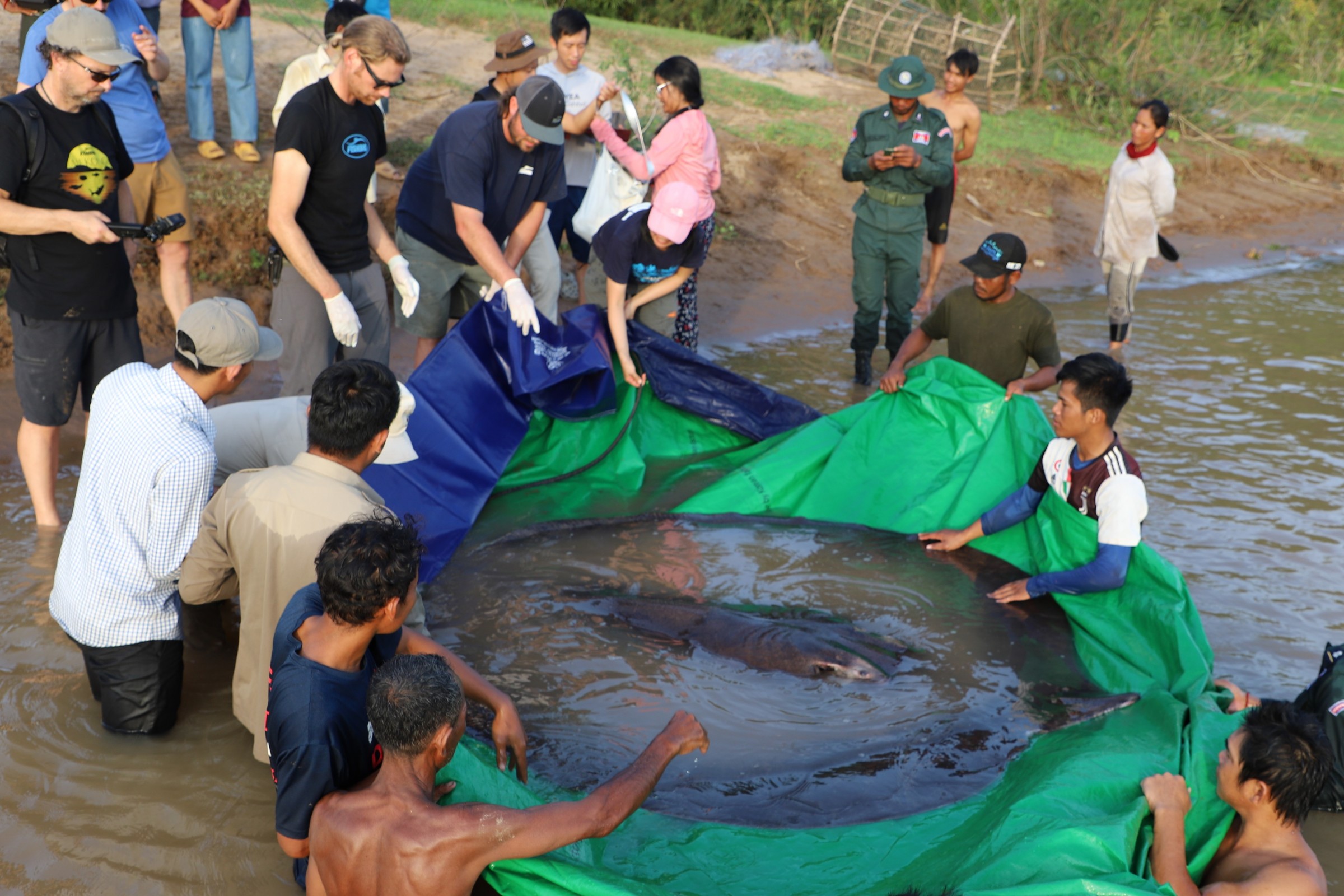Fish tracking project builds the case for international conservation cooperation.

In June 2022, fishers in Cambodia caught a giant freshwater stingray weighing 661 pounds (300 kilos). It turned out to be the largest freshwater fish ever caught. The stingray was tagged with a tracking device and returned to the Mekong River, where its movements are informing conservation planning. Photo courtesy of Chhut Chheana / Wonders of the Mekong
By Stefan Lovgren, special to Circle of Blue – January 10, 2023
The Mekong River, the longest waterway in Southeast Asia, is often called the world’s most productive river because it holds a greater abundance of freshwater fish than any other river basin on the planet.
From an ecological standpoint, there is one stretch of the river, in northern Cambodia — roughly 100 miles from the border with Laos and going downstream to the town of Kratie — that is particularly fertile. According to some estimates, an astounding 200 billion fish a year have been spawned in this area. Deep pools reaching down 260 feet serve as refuges for some of the world’s largest and most endangered freshwater fish species.
Despite its importance, little is known about this ecosystem and the biodiversity that exists here. The research project with which I’m involved is trying to change that. Called the Wonders of the Mekong, the project is funded by the U.S. Agency for International Development.
Increasingly, the project’s research has focused on this region of northern Cambodia, which, like the river as a whole, faces an existential crisis. An array of threats, from dam construction upstream to the increasingly pervasive impacts of climate change, have the potential to cause great peril, not only to the river but also to the communities that rely on it for food and culture.
Last year local fishers made a spectacular discovery in this region of ecological mysteries. In mid-June they caught a truly giant freshwater stingray (Urogymnus polylepis), an endangered species whose numbers elsewhere in Southeast Asia have plummeted.
The project has been working with the fishing community as part of its outreach program, encouraging fishers to report catches of highly endangered species, so that these animals, if caught, can be saved and released back into the river. In most cases, the stingrays, which are legal to catch in Cambodia despite their endangered status, are accidentally ensnared by fishers who are targeting other species. As part of the agreement, fishers are paid a sum of money equivalent to the market price for the fish in order to return it alive to the river.
The fisherman who reported catching the stingray said it was “much bigger” than any other he had ever seen. Hearing the news, our team members rushed to the site from Phnom Penh, the Cambodian capital. After the six-hour drive, they were stunned to find a stingray weighing 661 pounds (300 kilos). This made it the largest recorded freshwater fish in the world — a title confirmed by Guinness World Records — beating the previous record held by a Mekong giant catfish caught in northern Thailand in 2005. That fish weighed 646 pounds.
The discovery, which made big international headlines, underlined the importance of this island-strewn section of the Mekong as a refuge and potential breeding ground for the giant freshwater stingray. It also presented an unexpected opportunity to acquire vital scientific knowledge about this mysterious species, which we know very little about.
Researchers from one of our project partners, FISHBIO, a California-based conservation organization, happened to be in the region at the time. They were deploying the first-ever acoustic telemetry receiver network in the Cambodian Mekong River in order to study the migratory behaviors of Mekong fish species. When team members heard of the stingray catch, they immediately headed to the release site and were able to surgically implant, at the base of the stingray’s tail, an acoustic tag, before the giant fish was returned to the river.
Since then, the female stingray — which was named “Boramy,” or “full moon” in the Khmer language, because of her round shape and because there was a full moon the day she was released — has been detected by the acoustic network on multiple occasions. The tag will provide information that will help us learn more about the stingray’s behavior, including where it feeds, travels, and gives birth to pups.
“We’re now gathering data on the record stingray indicating that the area where it was caught is likely critical habitat for this globally significant population of giant stingrays,” says Zeb Hogan, a University of Nevada, Reno, fish biologist and the co-leader of the Wonders of the Mekong project.
For Hogan, the discovery of the record stingray was particularly exciting, culminating a two-decades-long personal search for the world’s largest freshwater fish.
Hogan stresses the importance of community involvement in both the research and conservation work, pointing out that fishers have contacted the Wonders of the Mekong team about releasing several other giant stingrays, in addition to Boramy.
“These fishers can actually be great allies in working to protect these animals,” says Hogan, who organized a workshop in Cambodia a few months ago that brought fisheries officials and local communities together to develop a conservation strategy for the giant freshwater stingray.
For the telemetry study, researchers aim to tag several hundred fish from many of the more than 100 species of fish that visit the area. These are species like the striped catfish, an important food fish in Cambodia, where people eat more fish per capita than in any other country in the world.
The goal is to improve the understanding of fish migration timing, routes, and distances in the Mekong River, and to identify locations of critical habitat. “This will help guide and target conservation of key spawning and rearing habitats, as well as important migratory corridors,” says Jack Eschenroeder, a fish biologist with FISHBIO, who helped set up the receiver network.
In total, 36 acoustic receivers have been deployed throughout the river basin at locations with suitable channel structure, areas with deep water and no obstacles that might block the tag signals of passing fish. Four receivers were attached to existing docks and floating homes along the Mekong’s edge, while the rest were mounted on floating platforms custom built by local communities.
Eschenroeder points out that this kind of system has not been extensively used in tropical systems before, largely because of challenging environmental conditions. “It is in many ways a groundbreaking approach,” he says.
The project is also collaborating with the Mekong River Commission, which has deployed a similar receiver network and is releasing tagged fish in Laos, across the border with Cambodia. Early downloads of receiver data have for the first time documented fish migrations between the two countries. This, researchers say, emphasizes the need for international cooperation to conserve Mekong fisheries. A database has also been created so that anyone tagging fish in the Lower Mekong Basin can share data and collaboratively track fish.
Hogan says it is all part of an effort to build a more complete picture of the mysterious lives of Mekong fish. “We’re only getting started.”
A frequent contributor to National Geographic, Stefan Lovgren often writes about freshwater conservation issues. He covers the Mekong River as part of the USAID project “Wonders of the Mekong.” Follow on Instagram @mekongwonders or visit his website.



